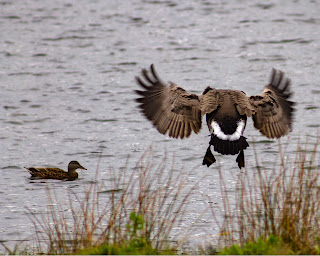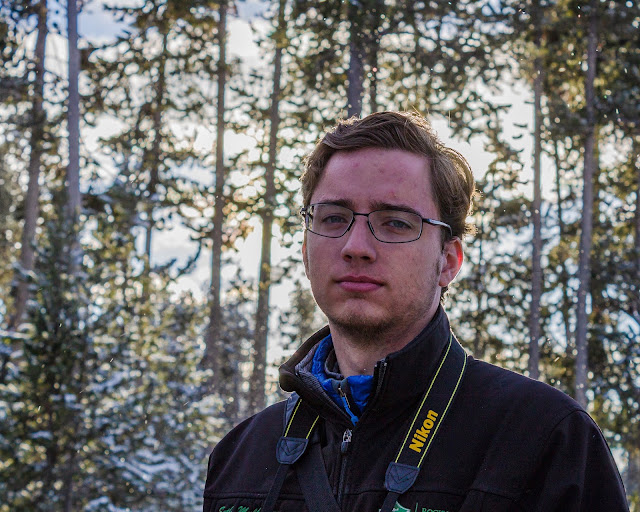Final Presentation
I used f/8.0 to give myself a greater depth of field; however, f/11 or even higher may have been more appropriate given the range of distances in the picture. I don't recall if I was in aperture or shutter priority when I took the picture, but I suspect aperture priority with f/8.0 as a compromise between shooting landscapes and shooting wildlife (we were looking for owls at the time I took this picture). There was plenty of light so ISO 100 allowed me to minimize graininess.
Shooting directly into the sun, I needed to let a very small amount of light into the camera, hence the relatively fast shutter speed, small aperture of f/14, and ISO 100. I was bracketing my exposures while in aperture priority mode (so my ISO and f-stop stayed constan), and I was happy with the exposure I got with 1/200 shutter speed.
The low light was not ideal when shooting this bison. Additionally, the movement of the subject required a fast shutter speed to prevent motion blurring (which is more likely in low light situations). I knew I wanted a small f-stop, both for a shallow depth of field to emphasize the subject while blurring the background, and to allow more light in, which helped some. I also knew I couldn't compromise on shutter speed. As such, my only option to fully ensure a decent exposure was to set the ISO to auto and allow the camera to optimize it in order to get the best exposure. I wound up with ISO 1250.
A very similar situation to the bison above. Low light, low f-stop, high shutter speed for moving subjects required that I set the ISO to auto to get a decent exposure.
Because this was a night shot, the objective was essentially to get as much light into the camera as possible, via low f-stop, long exposure (very slow shutter speed), and high ISO. I can't remember whether I set the ISO manually or automatically, but I'm glad I was able to get away with only 1600--I avoided some grain by not going to a higher number like 3200 or 6400. If I could redo this shot I would definitely use a tripod to allow me to aim the camera higher and get more sky in the picture.
Again, I was in aperture priority at a "compromise" aperture of f/8.0. Shooting into the sun (i.e. abundant light) allowed both a very fast shutter speed (crisp with no motion blur) and ISO 100 (very little grain).
I think I was in shutter priority for this one, because freezing the motion of the elk(?) was very important. As such, the ISO and aperture were left automatic to compensate (with higher ISO and lower f-stop). Even so, I had to really fiddle with the settings in Lightroom to get this one to look ok--I took this picture in the same location as the elk picture above, where the lighting was very much not ideal.
f/13 was probably overkill for this shot (given the small range of distances and the fact that I was shooting wildlife not landscape), but there was enough light that I got away with it. 1/160 shutter speed helped prevent blurring from the hand-held 600mm lens I was using, and the good lighting allowed me to do that with ISO 100.
I had my ISO fixed at 100, and I knew that I would have to get a fast shutter speed, either by lowering my f-stop as much as possible in aperture priority, or by going to shutter priority and selecting a reasonable shutter speed. I can't remember which one I did, but I think the settings worked out well in this picture, with just enough motion blur in the wingtips to give the picture a dynamic feel without diminishing the clarity of the rest of the goose, and the background water nicely out of focus. This picture was taken maybe a second after the other goose picture seen further below, and all of the same remarks apply to that picture.
I put the camera in aperture priority at f/11 because I was shooting a landscape. I don't remember if the ISO was set automatically but the low number is the reason the shutter speed is relatively slow, which admittedly gives a bit of nice blurring to the waterfall. Redoing this shot with a tripod or automatic ISO might not be a bad idea.
Similar to other pictures above, I had been at f/7.1 as a "compromise" while shooting wildlife just before this picture was taken. I actually think it's an appropriate aperture for this shot; however, since I didn't have a tripod to stabilize the shot in lower light, I should have set the ISO to automatic to allow the camera to increase it, thereby allowing me a shorter shutter speed (which would have reduced or eliminated blur).
Similar to the previous night shot, I wanted to get a lot of light into the camera. However, I could afford to make some sacrifices since I was shooting directly into the moon, a very bright light source. This allowed me to shorten the exposure to 20 seconds, and increase the f-stop to f/11 (to get both the clouds/sky and the tree in focus). ISO was left in auto.
I'm very pleased with how this picture turned out, which mainly resulted from my ability to brace the camera very firmly against a wooden post for the entire 30 second exposure (since I didn't have a tripod). I could have probably raised the ISO and increased aperture to bring more things into focus, though.
Another shot where I had an unnecessarily high f-stop (I was shooting over the railing of the walkway into the stream); I didn't bother to change it (I was also taking several landscape shots around the time this picture was taken) and it didn't really harm anything--there was enough light to get away with f/8.0 and ISO 100 while having a good handheld shutter speed of 1/125.
I'm happy with how this one turned out, and I think my settings were appropriate. I could have probably gone even higher on the f-stop, which would have reduced the size of the blown-out area around the sun.
Another picture where I think my settings were pretty appropriate--f/9.0 for the landscape element with a wide range of distances. Shooting into the sun allowed for a fast shutter speed at ISO 100.
See above remarks on the steaming river picture--the same ones apply to this picture too. I could have probably gone lower on the f-stop--a large depth of field was not terribly necessary here.
Another picture taken on the same day at Norris as the above two, under very similar conditions, hence similar settings.
See remarks on previous goose picture, which apply here as well.
f/8.0 for depth of field, ISO 100 to minimize grain, and 1/250 because I was shooting into the sun with lots of light.
ISO and shutter speed were appropriate for this shot (I think shutter speed might have been set automatically since I was probably in aperture priority) but I should have set the f-stop as low as possible--this was a macro shot and I had no reason to have anything but the lowest f-stop and smallest depth of field.
This was a difficult one to balance settings for, because the light was still fairly limited in the minutes leading up to sunrise. I didn't have a tripod so 1/30 was no doubt too slow for a handheld shot (although the blur is fortunately quite minor). I got away with a low ISO which I'm glad of; however, I would probably set ISO to be automatic if I were to retake this picture, to allow for a faster shutter speed and crisper handheld shot. f/8.0 was on the low side for a landscape like this but a decent compromise for the lower light conditions.
f/4.5 is far too low for a landscape like this (although I was focused mainly on the mountains, so the clarity of the dark foreground is not that big of a deal), but it did allow me a sufficiently fast shutter speed for a handheld shot at ISO 100.
I can't remember if I was in shutter priority or aperture priority for this picture, but either way I knew I needed a fast shutter speed to capture this woodpecker that was moving rapidly from branch to branch. 1/125 was honestly too slow since some blur is still visible, but nothing overly apparent. f/5.6 gave not only a nice shallow depth of field with blurred background, but also allowed for an ISO 100 shot.
I'm pretty happy with settings on this one. f/10 is a little low given the landscape subject, but the abundant light allowed for 1/500 and ISO 100 to yield a good exposure.




















































Comments
Post a Comment